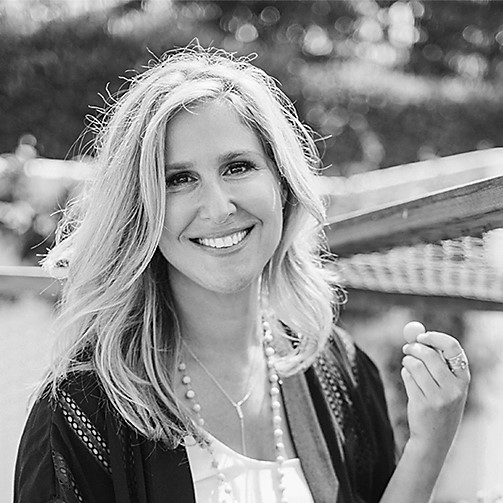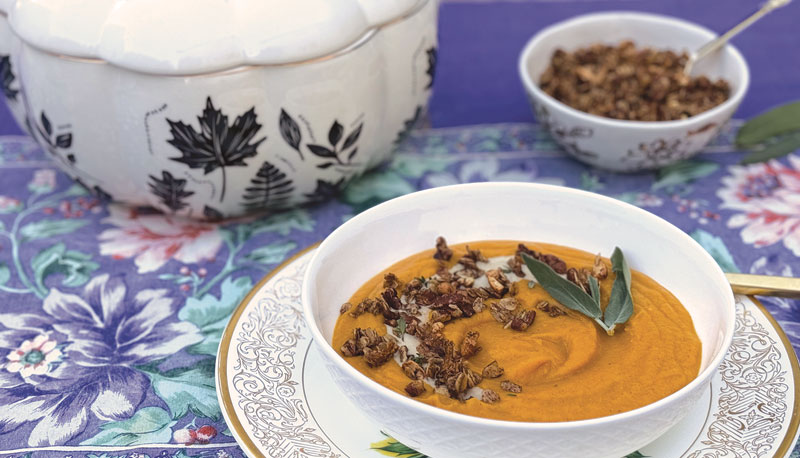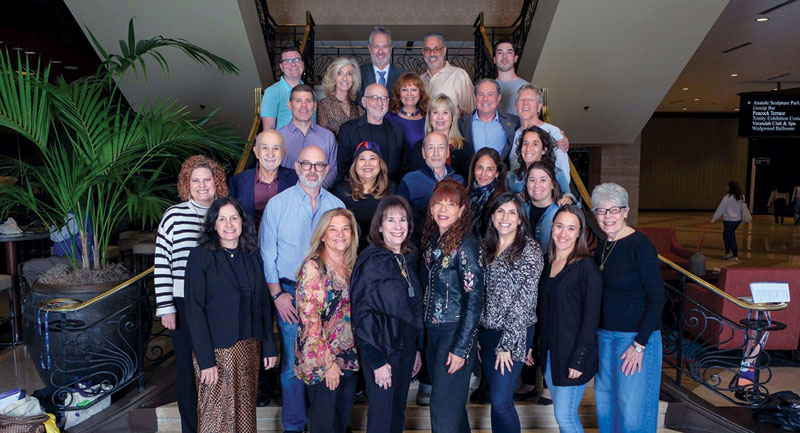[Video below!]
It’s easy to look like a frizzy-haired sweaty mess while cooking on camera. The studio lights beam into my eyes, the stove burners and ovens heat up the kitchen. And because the audience of the videos I am shooting will not be able to actually taste the latkes and applesauce I am preparing, vanity is not entirely superficial — my look is part of what I’m selling. I want to show all of YouTube that you can stay cool and calm while cooking for Chanukah.
When Jeff Appelbaum asked me to be one of the teaching chefs on his newly launched food channel, Salted, I jumped at the opportunity. Appelbaum and I share a mission: to provide extraordinary education in the world of cooking.
Although food shows have inundated our television airwaves, food television is not synonymous with cooking education. With programs like “Iron Chef” and “Diners, Drive-Ins and Dives,” the Food Network seduces viewers with saucy close-ups and sizzling competitions.
And though viewers, from the comfort of their own couches, are exposed to new types of cuisines and witness behind-the-scenes food preparation, they are left with hunger. They are not given any tools to satisfy that hunger with the use of their own pots and pans.
Essentially, television cooking shows offer food porn, a term that is now commonplace in our vernacular and one of the most searchable on social media platforms such as Instagram.
Just as we would not expect sexual pornography to improve the skills of lovers, we cannot expect food porn to turn anyone into a cook. And yet, if crafted with education in mind, video offers an ideal avenue to effectively teach cooking to a world that is already baited by the visual stimulae of food. That is the idea behind Salted, Appelbaum’s brainchild. Salted is a new type of cooking school. It is completely online. Members have full access to beautiful, high-definition videos of 70 world-class chefs, including New York City’s Jonathan Benno and Los Angeles’ Ori Menashe, teaching the skills and recipes they know best.
Appelbaum cites repetition as the No. 1 factor needed to learn culinary skill sets, and with Salted there is nothing stopping you from listening to your professors’ lectures more than once to make sure you picked up every detail as you test recipes in your own kitchen.
Appelbaum is disrupting the status quo by offering a quality culinary education at a fraction of the cost of most culinary schools. As The New York Times has reported, an onslaught of culinary-school graduates are faced with financial debts upward of $50,000, a sum far greater than they are able to recoup with $10-an-hour jobs in professional kitchens. At $99 a year, Salted offers wisdom from the most talented and passionate chefs at Netflix prices. For now, the majority of Salted members are hobbyists, and they hail from all over the world, including Cambodia and Bulgaria.
With a background in e-commerce entrepreneurship with startups such as DealQuad (a sort of Groupon for university students), Appelbaum is experienced at eliminating expensive obstacles and paving a cost-conscious path directly to the consumer.
“When I was starting my first business in L.A., the white noise in the background was the Food Network,” Appelbaum said. “It piqued my curiosity. As a culture, I saw that we were deeply engrossed in food and that our newest celebrities were chefs. We had over 3,000 farmers markets in the country, and food was the new hotbed of venture capital. I wondered how I could capitalize on this phenomenon and make it easier for people to learn to cook. The Internet might not be the answer to all of our problems, but I think it is the answer to most of them.”
Because Salted offers a year of online cooking courses for the price of one of my hands-on cooking classes, it is only fair that we address this question: Can people learn to cook from videos alone? In my professional opinion, no.
Cooking is a community-based undertaking. We must learn by eating each other’s foods, by being in the kitchen together, and by being willing to vulnerably share our creations with others.
Beginner cooks usually need some handholding in the kitchen. That’s what classes offer. On the other hand, more experienced cooks who are ready to take risks in the kitchen, no matter how small, can benefit from Salted’s detail-focused videos that address kitchen skills such as chopping and roasting, and that also anticipate common questions in each recipe video.
POTATO LATKES
- Three-Ingredient Roasted Applesauce (recipe below)
- 2 pounds russet potatoes, unpeeled
- 1 large onion, peeled
- 1 leek
- 2 tablespoons potato starch
- 1 egg
- 1 teaspoon salt, plus more for sprinkling
- 1 teaspoon freshly ground pepper
- 1 cup extra virgin olive oil for frying
Prepare Three-Ingredient Roasted Applesauce; refrigerate until serving time.
Grate potatoes (by hand) into a large bowl, using large holes of grater. (Using a food processor will not create the same texture.)
Grate onion on small holes of grater.
Remove outer layer of leek, and grate the white part only.
Add potato starch, egg, 1 teaspoon salt and pepper; mix with hands.
Heat a large, heavy-bottomed skillet over medium-high heat for 5 minutes.
Add olive oil to cover, about 1/4 cup at a time, and let it get very hot. (Test heat by dropping in a piece of potato; if it sizzles and browns easily, the oil is ready.)
Measure out about 1 tablespoon of potato mixture; squeeze between your hands to flatten and release the water.
Place in oil and fry until deep golden brown on both sides. Add more oil as needed to prevent burning.
Remove latkes from oil; place on paper towels. Sprinkle with salt and serve immediately, with applesauce, if desired.
Makes about 3 dozen dollar-size latkes.
THREE-INGREDIENT ROASTED APPLESAUCE
- 3 apples (Granny Smith, Fuji, Gala, etc.)
- 1 red pear (red Bartlett)
- 2 to 3 oranges
Peel apples, cut in half, and remove core.
Cut pear in half, and remove core. (Leave skin on.)
Place apples and pear in a baking dish. Juice the oranges; squeeze the juice of one orange on top.
Bake at 350 F for 35 to 45 minutes.
Place cooked fruit in food processor and pulse until well mixed; add some of the remaining orange juice and mix well. Taste, then add additional orange juice as desired.
Makes about 2 cups.
Sweet Potato Latkes
Ingredients:
- 2 cups coarsely grated sweet potatoes/yams (the orange ones) grated by hand on large holes of a grater from about 2 sweet potatoes/yams
- 2 cups coarsely grated leeks, on the large holes of a grater (*see note)
- 2 (organic) eggs
- 40-50 grinds of the pepper mill
- 1 teaspoon kosher salt + extra for sprinkling
- extra virgin olive oil for frying
Note: Go ahead and cut the bottom off the leeks and peel off the outer layer. Rinse again if you see mud. Now put the bottom of the leek to the grater and grate away on the large holes up until the medium green part … the light green is ok.
Put the sweet potatoes, leeks, egg, salt and pepper in a bowl and mix with hands.
Heat a heavy bottomed skillet over medium high heat for 5 minutes.
Add olive oil to cover, about 1⁄4 cup at a time, and let it get very hot. (Test by dropping in a piece of sweet potato, if its sizzles, the oil is ready for you.)
Pick up a tablespoon size of potato mixture. Squeeze between your hands to flatten and release the water. You don’t want it to be in a perfect circle … the little bits of potato that stick out will be the ones to get crispy.
Place in oil and fry until deep golden brown on each side.
Place on paper towels. Sprinkle with salt and serve immediately, with apple sauce if desired.
Makes 20 latkes.
Elana Horwich teaches cooking at Meal and a Spiel.
Jewish Journal readers can get 3 free months of Salted membership. At signup use the code “journal”























 More news and opinions than at a Shabbat dinner, right in your inbox.
More news and opinions than at a Shabbat dinner, right in your inbox.